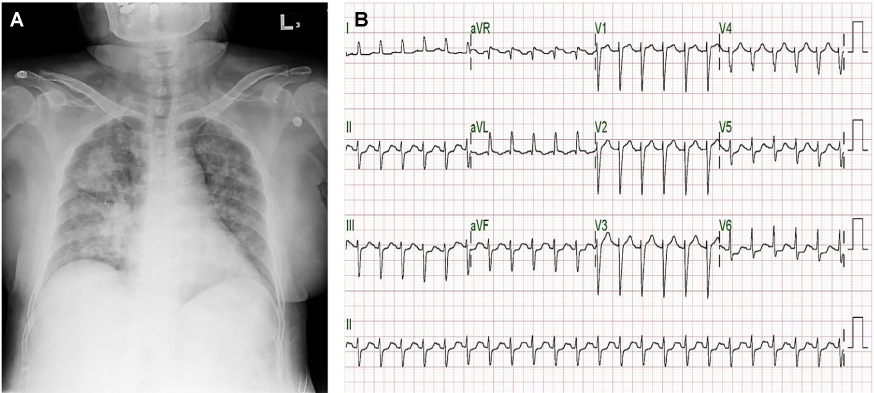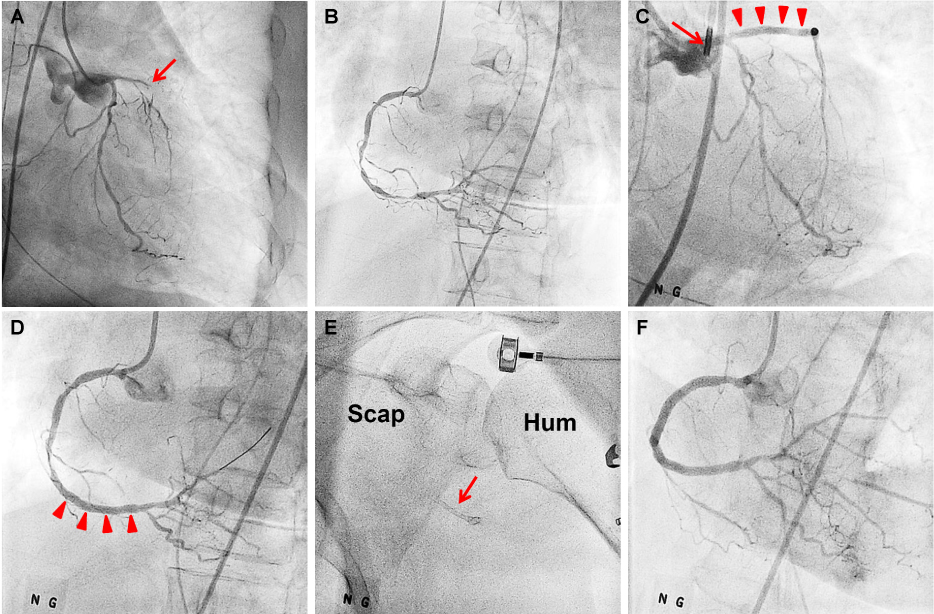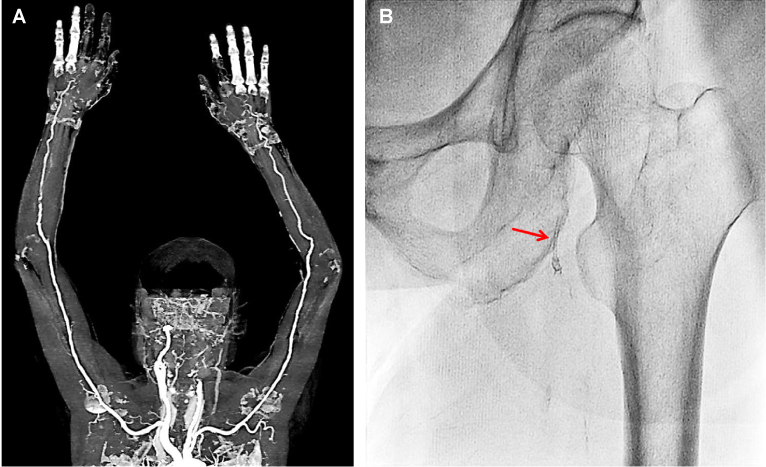J Lipid Atheroscler.
2016 Jun;5(1):87-92. 10.12997/jla.2016.5.1.87.
Re-mobilization of Lost Coronary Stent From the Axillary Artery to the Femoral Artery
- Affiliations
-
- 1Department of Internal Medicine, Boramae Medical Center, Seoul National University College of Medicine, Seoul, Korea. khl2876@gmail.com
- 2Department of Internal Medicine, Hongik Hospital, Seoul, Korea.
- KMID: 2328841
- DOI: http://doi.org/10.12997/jla.2016.5.1.87
Abstract
- Stent migration and loss are rare but can be devastating complications during percutaneous coronary intervention (PCI) for coronary artery disease. We report a unique case of wandering stent from the right coronary artery to the femoral artery via the axillary artery. Initially, the stent was stripped from the delivery catheter and embolized to axillary artery during emergent PCI. An intra-aortic balloon pump might have forced retrograde movement of the stent to axillary artery which have subsequently remobilized to the femoral artery. After stabilization, the stent was successfully removed by a percutaneous approach using a snare. Immediate retrieval of wandering stent is recommended for the prevention of secondary embolization.
MeSH Terms
Figure
Reference
-
1. GBD 2013 Mortality and Causes of Death Collaborators. Global, regional, and national age-sex specific all-cause and cause-specific mortality for 240 causes of death, 1990-2013: a systematic analysis for the Global Burden of Disease Study 2013. Lancet. 2015; 385:117–171.2. Amsterdam EA, Wenger NK, Brindis RG, Casey DE Jr, Ganiats TG, Holmes DR Jr, et al. 2014 AHA/ACC guideline for the management of patients with non-ST-elevation acute coronary syndromes: a report of the American College of Cardiology/American Heart Association Task Force on Practice Guidelines. Circulation. 2014; 130:e344–e426.3. Aggarwal B, Ellis SG, Lincoff AM, Kapadia SR, Cacchione J, Raymond RE, et al. Cause of death within 30 days of percutaneous coronary intervention in an era of mandatory outcome reporting. J Am Coll Cardiol. 2013; 62:409–415.
Article4. Alomar ME, Michael TT, Patel VG, Altomare CG, Rangan BV, Cipher D, et al. Stent loss and retrieval during percutaneous coronary interventions: a systematic review and meta-analysis. J Invasive Cardiol. 2013; 25:637–641.5. Brilakis ES, Best PJ, Elesber AA, Barsness GW, Lennon RJ, Holmes DR Jr, et al. Incidence, retrieval methods, and outcomes of stent loss during percutaneous coronary intervention: a large single-center experience. Catheter Cardiovasc Interv. 2005; 66:333–340.
Article6. Cha KS. Surgical retrieval of dislodged stent during transradial coronary intervention. J Invasive Cardiol. 2012; 24:E179–E181.7. Kim JH, Jang WJ, Ahn KJ, Song YB, Hahn JY, Choi JH, et al. Successful retrieval of intravascular stent remnants with a combination of rotational atherectomy and a gooseneck snare. Korean Circ J. 2012; 42:492–496.
Article8. Nguyen AH, Khan AA, Chait A, Fallahnejad M. The wandering coronary stent. Case report. J Cardiovasc Surg (Torino). 1998; 39:807–809.9. Shim BJ, Lee JM, Lee SJ, Kim SS, Lee DH, Shin WS, et al. Three cases of non-surgical treatment of stent loss during percutaneous coronary intervention. Korean Circ J. 2010; 40:530–535.
Article10. Berder V, Bedossa M, Gras D, Paillard F, Le Breton H, Pony JC. Retrieval of a lost coronary stent from the descending aorta using a PTCA balloon and biopsy forceps. Cathet Cardiovasc Diagn. 1993; 28:351–353.
Article11. Deftereos S, Raisakis K, Giannopoulos G, Kossyvakis C, Pappas L, Kaoukis A. Successful retrieval of a coronary stent dislodged in the brachial artery by means of improvised snare and guiding catheter. Int J Angiol. 2011; 20:55–58.
Article12. Juszkat R, Dziarmaga M, Zabicki B, Bychowiec B. Successful coronary stent retrieval from the renal artery. Cardiol J. 2007; 14:87–90.13. Mariano E, Versaci F, Gandini R, Simonetti G, Di Vito L, Romeo F. Successful coronary stent retrieval from a pedal artery. Cardiovasc Intervent Radiol. 2008; 31:655–658.
Article14. Applebaum RM, Wun HH, Katz ES, Tunick PA, Kronzon I. Effects of intraaortic balloon counterpulsation on carotid artery blood flow. Am Heart J. 1998; 135:850–854.
Article
- Full Text Links
- Actions
-
Cited
- CITED
-
- Close
- Share
- Similar articles
-
- Retrieval of a dislodged and dismounted coronary stent; using a rendezvous and snare technique at the brachial artery level via femoral approach
- Treatment of Stent Dislodgement Complicated by Coronary Artery Dissection using Parallel Wire Technique and Small Balloon
- A Morphological Study of the Branches of the Axillary Artery in Korean Female
- Study on the Branches of Axillary Arteries of Korean Adult
- Coronary Stent Fracture in a Patient with an Atrial Septal Defect and Severe Pulmonary Hypertension





